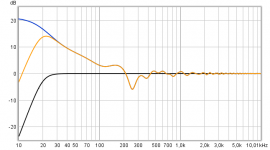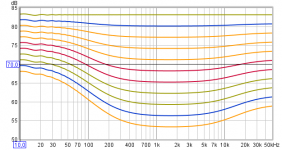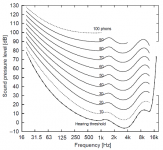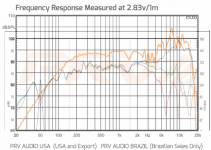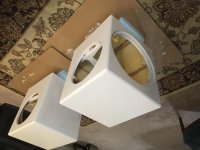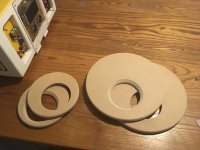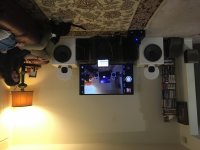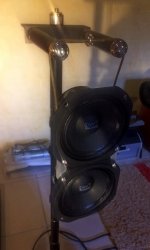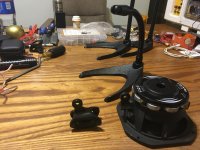Forgive me i can be wrong here but looking up the living room in post 381 it looks woofers get two very close boundery's and ploting such numbers in a dirty quick room simulation show you need about a 2nd order -3dB point roll off at 100Hz to arrive a final 2nd order system 20Hz roll off (speaker+room). Black trace below is 20Hz target as most track material is referenced to when mastered then divided by blue room curve result in orange target curve for JBL's : ) and a guess is your planned low end roll off is much too hot to sound any natural in room situation at post 381, but as said i could be wrong what is the real situation : )
[/QUOTE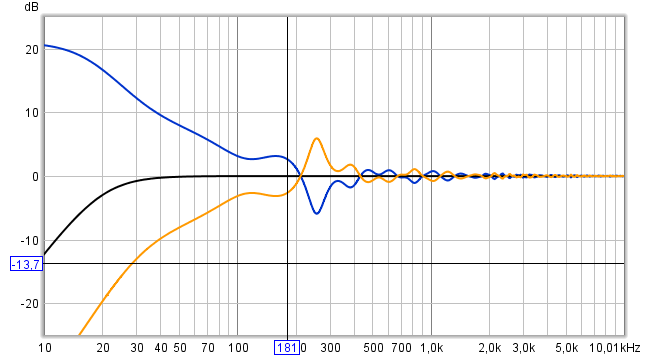
WOW...
I understood about 1/2 of what You wrote...
I’m currently living in an apartment “very temporary once I get this together” =snickering= so I plan to have a larger room.
I’m using a Minidsp to handle xover and room correction due to being a novice.“I’m learning”
You All have helped Me significantly and the time spent building this stuff with My two Sons has been priceless!
Forgive me i can be wrong here but looking up the living room in post 381 it looks woofers get two very close boundery's and ploting such numbers in a dirty quick room simulation show you need about a 2nd order -3dB point roll off at 100Hz to arrive a final 2nd order system 20Hz roll off (speaker+room). Black trace below is 20Hz target as most track material is referenced to when mastered then divided by blue room curve result in orange target curve for JBL's : ) and a guess is your planned low end roll off is much too hot to sound any natural in room situation at post 381, but as said i could be wrong what is the real situation : )
[/QUOTE
WOW...
I understood about 1/2 of what You wrote...
I’m currently living in an apartment “very temporary once I get this together” =snickering= so I plan to have a larger room.
I’m using a Minidsp to handle xover and room correction due to being a novice.“I’m learning”
You All have helped Me significantly and the time spent building this stuff with My two Sons has been priceless!
OK, I think I understand now, blue line is room gain
Orange is My target.
Recommendations are to achieve the black.
My room is 13’ wide 8’ tall 17’ deep.
Large openings on left side opening into dining room.
I truly am working to get this stuff understood!
You right there and that example was to explain one don't always need that much low end inside a real room as if system was for wide open outdoor use, it was the rebuild story of your JBL's that sounded for me as in the new enclosure combined the 18 incher passive radiators you would tune them to say a 20Hz 4th order roll off or something, and say that was intended target below will show what happens using same room data as previous example, black trace in previous example was a 2nd order roll off target at 20Hz in below 2nd order is upped to 4th order to simulate a passive radiator ported system roll off, blue is the same room gain and black times blue output sum is orange curve. Below can probably sound impressive for some ears but not sure it ever get to sound natural as the real acoustic instruments do and the good thing about get it relaxed is the less stroke we ask from transducer the cleaner non distorted lows it performs.
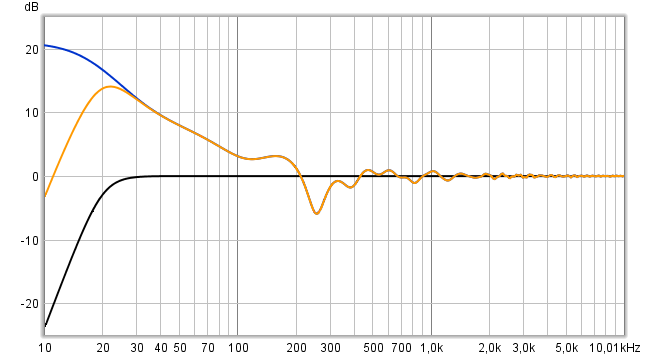
Thanks your room size numbers i can then get back later with more precise predictions and links to spreadsheet and good guides on paper for low end stuff.
Thanks your room size numbers i can then get back later with more precise predictions and links to spreadsheet and good guides on paper for low end stuff.
Attachments
Last edited:
Your most helpful information has sent Me down a rabbit hole of research.You right there and that example was to explain one don't always need that much low end inside a real room as if system was for wide open outdoor use, it was the rebuild story of your JBL's that sounded for me as in the new enclosure combined the 18 incher passive radiators you would tune them to say a 20Hz 4th order roll off or something, and say that was intended target below will show what happens using same room data as previous example, black trace in previous example was a 2nd order roll off target at 20Hz in below 2nd order is upped to 4th order to simulate a passive radiator ported system roll off, blue is the same room gain and black times blue output sum is orange curve. Below can probably sound impressive for some ears but not sure it ever get to sound natural as the real acoustic instruments do and the good thing about get it relaxed is the less stroke we ask from transducer the cleaner non distorted lows it performs.
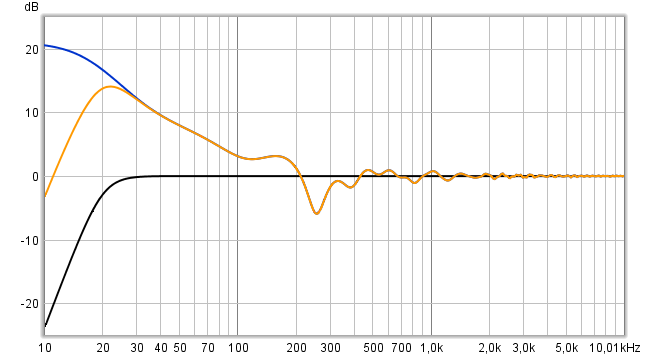
Thanks your room size numbers i can then get back later with more precise predictions and links to spreadsheet and good guides on paper for low end stuff.
After digging into room response I’ve fallen down a path including;
Fletcher-Munson curves.
I just finished a coat of paint and anxious to get these together with My microphone and see how all this all looks and sounds!
You’ve been most beneficial to My education in My first love of audio!
Thank You!
EDIT - oops, some of this was already stated in post 399.
I think these differences are from PRV being non-standard / a bit creative with their specs.
"power handling 225w"
Beyma use AES tests.
"The driver shall be excited with a band of pink noise extending one decade upward from the manufacturer’s stated lowfrequency (lf) limit of the device"
That's 150Hz for the Beyma.
PRV use a 290Hz crossover for "full power handling". That's a gentler test, guaranteed to result in a more impressive number.
"Sd on PRV is larger"
Based on the dimensional drawings, the Sd should be the same. PRV probably just include more of the surround in their measurement.
"PRV: 94dB at 2.83v"
The PRV spec sheet I'm looking at doesn't state it this way. They use 2V at 1m (with a 3.7ohm driver).
https://www.parts-express.com/pedocs/specs/294-2704--prv-audio-5mr450-ndy-4-specifications.pdf
Real efficiency should be identical, or near to (the drivers have essentially the same Fs, VAS and Qes).
Lots of apples to oranges in their spec sheets.
Beyma’s: 92dB at 1w and power handling of 100w AES, 200w program, 17kHz top end
PRV: 94dB at 2.83v power handling 225w 16kHz top end
Qts seems higher on PRV and it can handle more power, Sd on PRV is larger also. I don’t think they are identical. They look like they use the same frame though.
I think these differences are from PRV being non-standard / a bit creative with their specs.
"power handling 225w"
Beyma use AES tests.
"The driver shall be excited with a band of pink noise extending one decade upward from the manufacturer’s stated lowfrequency (lf) limit of the device"
That's 150Hz for the Beyma.
PRV use a 290Hz crossover for "full power handling". That's a gentler test, guaranteed to result in a more impressive number.
"Sd on PRV is larger"
Based on the dimensional drawings, the Sd should be the same. PRV probably just include more of the surround in their measurement.
"PRV: 94dB at 2.83v"
The PRV spec sheet I'm looking at doesn't state it this way. They use 2V at 1m (with a 3.7ohm driver).
https://www.parts-express.com/pedocs/specs/294-2704--prv-audio-5mr450-ndy-4-specifications.pdf
Real efficiency should be identical, or near to (the drivers have essentially the same Fs, VAS and Qes).
Lots of apples to oranges in their spec sheets.
Last edited:
Hi Hollowboy,
I think you are looking at th 4ohm PRV which has very different TS parameters. But perhaps the power ratings are "creative', could be... The sensitivity is 2.83v at 1m (per the PRV is more than 1w of input power as Re is <8ohms.
The 8 ohm is here:
https://www.parts-express.com/pedocs/specs/294-2705--prv-audio-5mr450-ndy-specifications.pdf
Upon closer inspection, I don't think the frames are the same. The PRV's cast aluminum bezel is a squared-off or truncated circle (like a large TC9FD), whereas the Beyma is a true pincushion bezel (with rounded sides - no flats anywhere). So I think we should stop comparing these like they were made by the same factory. The Le (at 1kHz) of the PRV is also 6.7x smaller than the Beyma.
Beyma pincushion:

PRV truncated circle:
I think you are looking at th 4ohm PRV which has very different TS parameters. But perhaps the power ratings are "creative', could be... The sensitivity is 2.83v at 1m (per the PRV is more than 1w of input power as Re is <8ohms.
The 8 ohm is here:
https://www.parts-express.com/pedocs/specs/294-2705--prv-audio-5mr450-ndy-specifications.pdf
Upon closer inspection, I don't think the frames are the same. The PRV's cast aluminum bezel is a squared-off or truncated circle (like a large TC9FD), whereas the Beyma is a true pincushion bezel (with rounded sides - no flats anywhere). So I think we should stop comparing these like they were made by the same factory. The Le (at 1kHz) of the PRV is also 6.7x smaller than the Beyma.
Beyma pincushion:

PRV truncated circle:
An externally hosted image should be here but it was not working when we last tested it.
Last edited:
Your most helpful information has sent Me down a rabbit hole of research.
After digging into room response I’ve fallen down a path including;
Fletcher-Munson curves.
I just finished a coat of paint and anxious to get these together with My microphone and see how all this all looks and sounds!
You’ve been most beneficial to My education in My first love of audio!
Thank You!
Hope that rabbit hole research : ) will help and pay back upped performance down the road so that low frq domain for speaker plus room lines up nicely to improve system get some closer to natural sound than usual way where one simply live with whatever speaker system in whatever room position will perform, also miniDSP active unit should help dial in a good system. About Fletcher Munson curves which was updated or renamed to Equal loudness ISO226_2003 curves will say they can be easy to misunderstand that we want bass boost all the time because of that huge threshold at lows seen in second graphs attached below. Case is when most track material was mastered its bass ballance was dialed in at about 86dB SPL for a stereo set of speakers on a relative smooth system, so we want also a smooth low end in cooperation with room and a 86dB SPL at listening position to get same bass ballance reference as when track was mastered, but as we dial volume lower and lower we loose reference to that reference mastered bass ballance at 86dB SPL because of ISO226 curve for our hearing. Know one of RME's DACs have build in ISO226 or equal loudness filter for its internal volume also my self use JRiver as player and its internal volume can be calibrated to 86dB (stereo set) SPL at listening position and below graphs is a I/O loopback test of my soundcard so we can see its magic as volume is dialed lower and lower.
Attachments
Hi Hollowboy,
I think you are looking at th 4ohm PRV which has very different TS parameters. But perhaps the power ratings are "creative', could be... The sensitivity is 2.83v at 1m (per the PRV is more than 1w of input power as Re is <8ohms.
The 8 ohm is here:
https://www.parts-express.com/pedocs/specs/294-2705--prv-audio-5mr450-ndy-specifications.pdf
The 8 ohm specs have a higher Fs (good for efficiency) but higher Qes (bad for efficiency).
Punching those numbers into a calculator gives an efficiency of 91.3dB:
HiFi Loudspeaker Design
That, of course, assumes spherical cows. Spherical cow - Wikipedia
In practice, PRV might be able to quote a different efficiency number due to beaming, rising response etc. But the pistonic output from a PRV 5" appears to be very similar to equivalent gear from other companies.
...and, honestly, how could it be better? If PRV were magically able to get double the sensitivity AND power handling, every other company would eagerly study and imitate their tech.
TL;DR
To me, the Beyma looks just as efficient / good. If I were shopping around, I'd buy whichever was locally cheaper.
YES!Hope that rabbit hole research : ) will help and pay back upped performance down the road so that low frq domain for speaker plus room lines up nicely to improve system get some closer to natural sound than usual way where one simply live with whatever speaker system in whatever room position will perform, also miniDSP active unit should help dial in a good system. About Fletcher Munson curves which was updated or renamed to Equal loudness ISO226_2003 curves will say they can be easy to misunderstand that we want bass boost all the time because of that huge threshold at lows seen in second graphs attached below. Case is when most track material was mastered its bass ballance was dialed in at about 86dB SPL for a stereo set of speakers on a relative smooth system, so we want also a smooth low end in cooperation with room and a 86dB SPL at listening position to get same bass ballance reference as when track was mastered, but as we dial volume lower and lower we loose reference to that reference mastered bass ballance at 86dB SPL because of ISO226 curve for our hearing. Know one of RME's DACs have build in ISO226 or equal loudness filter for its internal volume also my self use JRiver as player and its internal volume can be calibrated to 86dB (stereo set) SPL at listening position and below graphs is a I/O loopback test of my soundcard so we can see its magic as volume is dialed lower and lower.
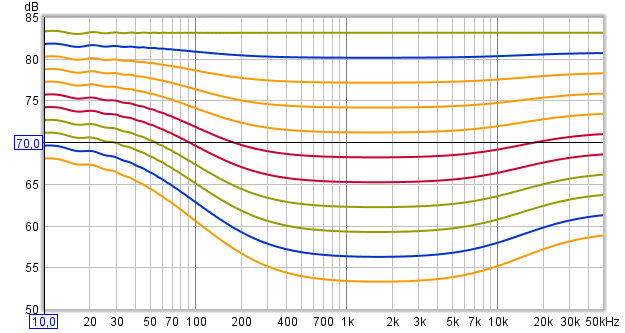
This is incredible!
The boombox I built I’m using a 2x4 minidsp that’s tuned flat at about 90dbspl, quiet listening is very lacking, once I get My new system built I’m planning to program a quiet listening program... unfortunately I haven’t found a way to adapt the gain to change as Your DAC does.
Regardless this has been an exciting venture!
Without question My equipment will sound far more amazing and I understand why and how to do it!
I’m a retired instrumentation calibrator/Instructor “mostly for process piping as I’m a Union Steamfitter” and passing on knowledge has been ingrained.
As I become more confident, Your helping Me will certainly continue with others.
Thank You for Your time helping Me understand!
You’ve been most valuable!
Hi Hollowboy,
I think you are looking at th 4ohm PRV which has very different TS parameters. But perhaps the power ratings are "creative', could be... The sensitivity is 2.83v at 1m (per the PRV is more than 1w of input power as Re is <8ohms.
The 8 ohm is here:
https://www.parts-express.com/pedocs/specs/294-2705--prv-audio-5mr450-ndy-specifications.pdf
Upon closer inspection, I don't think the frames are the same. The PRV's cast aluminum bezel is a squared-off or truncated circle (like a large TC9FD), whereas the Beyma is a true pincushion bezel (with rounded sides - no flats anywhere). So I think we should stop comparing these like they were made by the same factory. The Le (at 1kHz) of the PRV is also 6.7x smaller than the Beyma.
Reminiscing back to post #59 I remember nearly pulling the trigger on this unit as it was slightly cheaper in the UK than the PRV.
At the time, the chassis was IDENTICAL to the PRV, with the square cut outs and number of magnets. In the end, I did go for the PRV's, but kept an eye on the Beyma which was eventually discontinued.
A recent search shows it has now been resurrected, even using the same name. However, the chassis surround has been altered as was as the magnet count which has gone from 10 to 8, although they appear to be a larger diameter.

Strangely, all the old online images of these unit now point to the new driver. I have not been able to find a picture of the old driver from years ago, and I never saved it.
There may have been some copyright infringement which caused Beyma to take the original off the market & alter the design.....who knows....
I'm also looking at 5" midrange candidates for my multichannel OB, where subwoofer and midbass already use pro audio drivers. this PRV seems interesting but comparing to Satori Mr13p-8, PRV shipment + customs fee might be more expensive but outcome with higher sensitivity and power rating
i just compared both of their MLS result and basicly they share same typical response. in real home audio usage, will the extra muscle from PRV has any advantage compared to more popular 5" like Satori or illuminator?
on the graph, orange is PRV and blue-green-red is from Satori
i just compared both of their MLS result and basicly they share same typical response. in real home audio usage, will the extra muscle from PRV has any advantage compared to more popular 5" like Satori or illuminator?
on the graph, orange is PRV and blue-green-red is from Satori
Attachments
I'm also looking at 5" midrange candidates for my multichannel OB, where subwoofer and midbass already use pro audio drivers. this PRV seems interesting but comparing to Satori Mr13p-8, PRV shipment + customs fee might be more expensive but outcome with higher sensitivity and power rating
i just compared both of their MLS result and basicly they share same typical response. in real home audio usage, will the extra muscle from PRV has any advantage compared to more popular 5" like Satori or illuminator?
on the graph, orange is PRV and blue-green-red is from Satori
I have tried a number of units in this application including most of the MA range, Dayton & Vifa units recommended by XRK, plus a NEO10 Ribbon.
There is no doubt the PRV (and maybe Beyma) have something special regarding dynamics that the other units lacked. Whether its because of the high efficiency I dont know. No other mid/FR I have tried is as fast or had the ability to get loud & respond to dynamics so quickly.
that is encouraging experience, because I also want to use my system for movie, only need stereo, or maybe additional centre channel only 😀 I have used AN and MA drivers too but never found any high efficiency & power rating driver yet at this 5" range.I have tried a number of units in this application including most of the MA range, Dayton & Vifa units recommended by XRK, plus a NEO10 Ribbon.
There is no doubt the PRV (and maybe Beyma) have something special regarding dynamics that the other units lacked. Whether its because of the high efficiency I dont know. No other mid/FR I have tried is as fast or had the ability to get loud & respond to dynamics so quickly.
JBL/PRV functioning!
Progress report!
Woofers are complete, PRVs mounted in the baffles, temporarily wired up and functional.
I need to build some nice support stands for the PRVs to set in but for now this will work.
Using My theater Minidsp processor temporarily until the 2x4hd arrives.
A quick crossover at 500hz and setting the gains by ear “no equalization or adjustments for room” I’m hearing things in material I didn’t know existed!
The speakers completely disappeare audibly!
I’ve never experienced anything like this before and I’m awestruck!
Everything is effortless and the sound is as I’m in the room where the music is being recorded!
Tomorrow I intend to get My microphone out and adjust for room and get everything close to where it should be.
I have no idea how this will sound dialed in but one thing is certain, I’m currently in new territory for the most amazing, real sounding, audio reproduction.
I never quite understood “the speakers disappear” until now!
Thank You Everyone for being a part of this journey!
Thank You for Your help and posting discussions as I’ve learned much and benefiting in ways I never knew were possible.
Has anyone used “the wet look” paper cone speaker coating?
Pros/cons should or shouldn’t recommendations?
Progress report!
Woofers are complete, PRVs mounted in the baffles, temporarily wired up and functional.
I need to build some nice support stands for the PRVs to set in but for now this will work.
Using My theater Minidsp processor temporarily until the 2x4hd arrives.
A quick crossover at 500hz and setting the gains by ear “no equalization or adjustments for room” I’m hearing things in material I didn’t know existed!
The speakers completely disappeare audibly!
I’ve never experienced anything like this before and I’m awestruck!
Everything is effortless and the sound is as I’m in the room where the music is being recorded!
Tomorrow I intend to get My microphone out and adjust for room and get everything close to where it should be.
I have no idea how this will sound dialed in but one thing is certain, I’m currently in new territory for the most amazing, real sounding, audio reproduction.
I never quite understood “the speakers disappear” until now!
Thank You Everyone for being a part of this journey!
Thank You for Your help and posting discussions as I’ve learned much and benefiting in ways I never knew were possible.
Has anyone used “the wet look” paper cone speaker coating?
Pros/cons should or shouldn’t recommendations?
Attachments
I’m at 50% photos posting right side up...
Perhaps one day I’ll get this figured out.
Once dialed in, I’ll play around with baffle shapes and see their effects.
The bit of research I’ve done, My thinking these should be decent for My higher crossover point.
Having the drivers offset on a circle should eliminate the edge diffraction being the edge is continually changing length from the source?
Does this make sense?
Thoughts?
Perhaps one day I’ll get this figured out.
Once dialed in, I’ll play around with baffle shapes and see their effects.
The bit of research I’ve done, My thinking these should be decent for My higher crossover point.
Having the drivers offset on a circle should eliminate the edge diffraction being the edge is continually changing length from the source?
Does this make sense?
Thoughts?
I’m at 50% photos posting right side up...
Perhaps one day I’ll get this figured out.
Once dialed in, I’ll play around with baffle shapes and see their effects.
The bit of research I’ve done, My thinking these should be decent for My higher crossover point.
Having the drivers offset on a circle should eliminate the edge diffraction being the edge is continually changing length from the source?
Does this make sense?
Thoughts?
Personally, I would get rid of the baffle which just colours the sound and disrupts imaging 😉 . With FAST application you dont need to worry about bass loss.
With a suspended type arrangement, you could still place the PRV's on the Bass cabinet and isolate from vibrations, which would be severe.
Attachments
Last edited:
Nice work JeffreyAmes. I like the plain white cabinet look.
A circle with offset is good from diffraction standpoint, but probably not as good as a trapezoid or a Fibonacci spiral as those are more asymmetric, whereas there is a diametric symmetry on an offset circle - but probably fine. Definitely better than a symmetric concentric circle - the worst baffle shape from diffraction standpoint. It looks great though.
That’s great that it sounds good out of the box without any microphone measurements. If you are looking g for a good mic, Cross Speectum Labs sells third party calibrated UMIK-1 for $105.
A circle with offset is good from diffraction standpoint, but probably not as good as a trapezoid or a Fibonacci spiral as those are more asymmetric, whereas there is a diametric symmetry on an offset circle - but probably fine. Definitely better than a symmetric concentric circle - the worst baffle shape from diffraction standpoint. It looks great though.
That’s great that it sounds good out of the box without any microphone measurements. If you are looking g for a good mic, Cross Speectum Labs sells third party calibrated UMIK-1 for $105.
Progress report;
I picked up some little table top microphone stands on clearance at parts Express, I really wanted to showcase the magnetic structure on these drivers.
I’m VERY pleased with this no baffle look!
I’ll probably try the smaller circles on the other stands to see how they look as well.
The microphone stands were only $9.00 USD each!
XRK; I do Own the Minidsp microphone for measuring, today My new Minidsp 2x4HD arrived so I’ll be getting some measurements soon as all is hooked up!
I only needed to cut up the microphone holder to form a bracket, then drill a hole for a M3 screw, the unused termination tab on the opposite side is tapped for the M3, I might use a drop of lock tight and or add a nut later.
This system is very close to completion!
Just in time for My kids spring break!
I picked up some little table top microphone stands on clearance at parts Express, I really wanted to showcase the magnetic structure on these drivers.
I’m VERY pleased with this no baffle look!
I’ll probably try the smaller circles on the other stands to see how they look as well.
The microphone stands were only $9.00 USD each!
XRK; I do Own the Minidsp microphone for measuring, today My new Minidsp 2x4HD arrived so I’ll be getting some measurements soon as all is hooked up!
I only needed to cut up the microphone holder to form a bracket, then drill a hole for a M3 screw, the unused termination tab on the opposite side is tapped for the M3, I might use a drop of lock tight and or add a nut later.
This system is very close to completion!
Just in time for My kids spring break!
Attachments
- Home
- Loudspeakers
- Full Range
- PRV 5MR450-NDY for FAST/WAW applications
